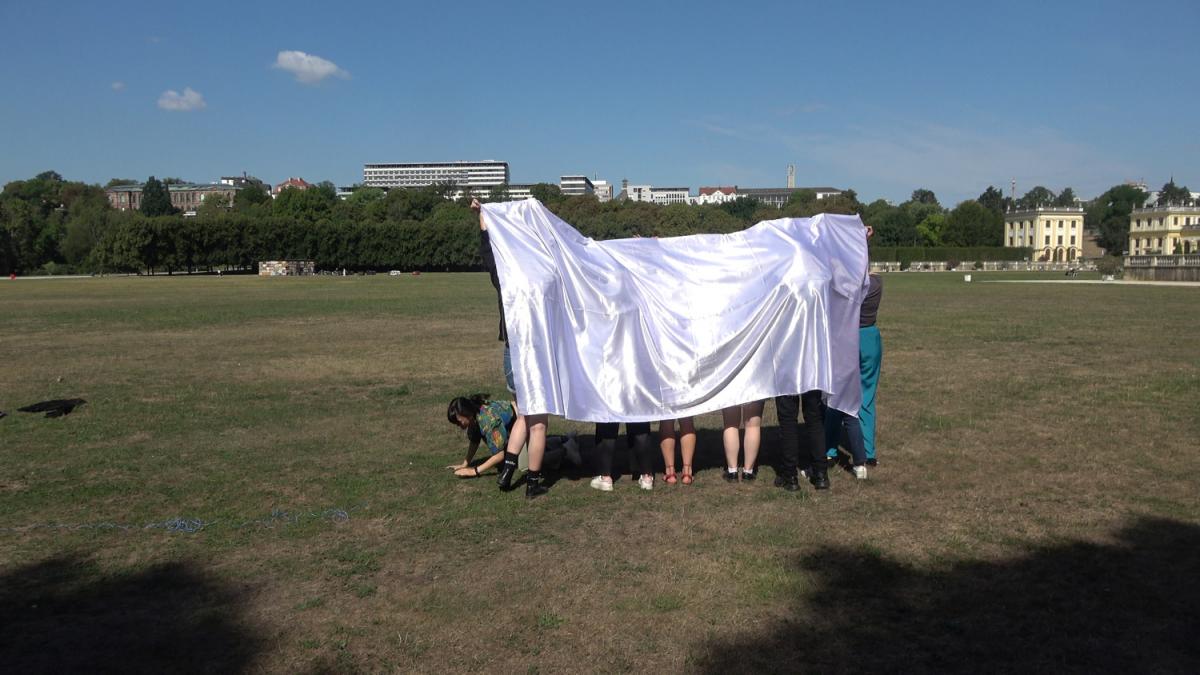Imagining Contemporary Art Otherwise, Lumbung One
Written by Onur Tayranoğlu, student in Live Art and Performance Studies.

We started our second study year 2022-2023, with a trip to Documenta 15 with two other universities, Kassel University and the Academy of Art in Szczecin. Our trip was funded by Erasmus+ and Live Art and Performance Studies programme, which made it possible for us to spend 5 days in Kassel, visiting the exhibition, workshopping and meeting with the curatorial team Ruangrupa and many artists that are involved or visiting, at the same time with us.
Documenta is a contemporary art exhibition that takes place every 5 years, in Kassel, Germany. Perhaps, because it is highly mentioned within the western art historical canon, I was very curious to experience my first Documenta. I was pretty much aware of its history, and how it is situated as an institution that challenges and redefines contemporary art simultaneously, as one could call, a “trendsetter”. Nonetheless, I was also aware of the fact that the previous exhibitions have been often critiqued for presenting mainly if not only, well-known artists who often happen to be from Global North. Don’t get me wrong, it is not only a problem of Documenta but almost all blockbuster contemporary art exhibitions. Therefore, when we see non-European or non-Northern American artists or curators in charge of an exhibition, it is praised as a big step for the art world. In Documenta 15, this step felt unbelievably big, I was curious to see how an art institution could deal with the conflicts that might arise between its established structure, history, and tradition that was inherently “white” and the curatorial team which was the Indonesian artist collective, Ruangrupa and artist collectives they have invited. Since the opening day, many scandals broke out in the media which I don’t want to dig deep into it now, but I am sure you can access them easily on the world wide web. My point is that while art institutions claim to open up inclusive spaces by inviting a diverse group of artists and curators, they miss out on the fact that inclusive space requires more than an invitation. I find the questions of structural changes and the safety of the participating artists and curators, very crucial for the art institutions who attempt for such invitations and got credited for it.
Besides all the drama western media has displayed and my critical look at the institution of Documenta, I don’t want to make an injustice to the curatorial team and the participating artists and artist collectives by not talking about the artistic work put into it. In my opinion, Ruangrupa had a very bold curatorial method prioritizing artist collectives and artists who work collectively also with a consideration of financial resource distribution. Even though there was not a claimed theme for artworks, there was an emphasis on the collaborative model which they call Lumbung. Lumbung is an Indonesian term directly translated as “rice barn” but refers to the communal practice of collecting and storing what has been harvested in the community as a shared common
resource for the future. In their curatorial approach, Lumbung functions more than a metaphor but a practice of collective accumulation and sharing of resources, not only limited to financial but also artistic and collaborative knowledge. This approach has not only resulted in an exhibition but also in a community of artists called Lumbung which will continue to function in one way or another even after Documenta 15. I am looking forward
to seeing in what form and how.
Documenta 15, or as the artistic team calls it, Lumbung One was an enormous exhibition that included more than artworks which the contemporary art audience is used to seeing, it required more than seeing but lots of reading, listening, watching and socializing. I think one of the best parts of the exhibition was the social spaces it created even if they were temporal, limited to 100 days that the exhibition takes place. During our visit, we had the chance to meet with Ruangrupa and many artists of Lumbung in those spaces. Furthermore, visiting the exhibition as parts of the institutions of art education also facilitated these encounters with planned gatherings and workshops. Nonetheless, as I have heard from the locals of Kassel, this has been the most welcoming and engaging Documenta for them. Indeed, I see it as an achievement for an art event that attracts thousands of tourists to the city, to be still engaging with the residents of the city.
Furthermore, utilizing those spaces for an intensive, 5 days long gathering with artists from other academies and trying to think together was a practice that doubled itself with the intentions of Lumbung. Our field trip to Documenta 15 started, or perhaps motivated us to continue, with the discussions within our group around the topics of forms and practices of collectivity, social and economic reality and the future of arts and culture both
locally and globally. More importantly, it was a rare chance to meet so many artists from all around the globe and with their methods and practices, which I appreciate a lot.
When performance
The master’s programme in Live Art and Performance Studies (LAPS) was launched in 2001 as a Finnish-language degree programme, Esitystaiteen ja -teorian koulutusohjelma. Since 2013, LAPS has been an English-language, international and residential MA programme based in Helsinki. The objective of the programme is to enable artists coming from different environments, classes, cultures and upbringings to focus on their work, develop their research and map out the future of their artistic practice. This blog discloses the various aspects of the LAPS programme, from individual notions and statements by students to providing background for LAPS MA thematic interests.
Learn more about the LAPS programme
Latest posts
Follow blog